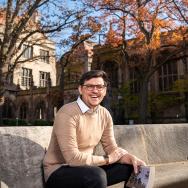Editor’s note: This story is part of ‘Meet a UChicagoan,’ a regular series focusing on the people who make UChicago a distinct intellectual community. Read about the others here.
One fateful day last fall, the SARS-CoV-2 virus infected a human for the first time, precipitating an outbreak in central China that would intensify into a global pandemic.
When the news began to make international headlines in January, Holly Lutz, AB’09, was not surprised. The University of Chicago alum was already familiar with the devastating threat posed by zoonoses: diseases—like HIV, Ebola and now COVID-19—that jump from animals to humans.

“Scientists have been raising this kind of red flag for decades,” said Lutz, who is an expert on disease ecology in bats, the suspected original host for the coronavirus.
Now an assistant project scientist at the University of California San Diego, Lutz studies animal pathogens and parasites.
She knows first-hand how debilitating infections associated with animals can be: In 2013, while scouting for bats in a hollowed-out strangler fig tree in Uganda, she became infected with histoplasmosis—a fungal lung disease caused by inhaling spores that live on bat guano.
Her initial symptoms were a fever, headache and dry cough. But within weeks, she became physically weak, losing weight and feeling tired even after her fever had subsided.
“It was pretty debilitating for about six months,” said Lutz, who is also a research associate at the Field Museum of Natural History. “As a fungal infection, it can be hard to treat, because the medications that fight it have the potential to harm your own cells.”

After receiving an IV and spinal taps in Chicago, Lutz made a full recovery. But the experience had an impact on the way she approaches her work with bats: She always wears a CDC-recommended respirator mask in caves and is cautious when handling live animals.
Her work helps the scientific community prepare for future pandemics, while elucidating patterns of disease evolution and the role of the microbiome—the bacteria that live naturally in and on our bodies—in health and well-being.
“I’m very interested in the microbiome in bats and birds, and in asking big questions like ‘Does flight impact the evolution of your microbiome?’” she said. “Now, those questions are coming full circle, as we try to understand how the microbiome can actually impact your susceptibility to something like COVID-19.”
“Scientists have been raising this kind of red flag for decades.”
A wild goose chase
Despite the danger, Lutz said fieldwork is essential to the development of her ideas as a scientist, which are rooted in a fascination with our planet’s unique biodiversity.
“I started thinking about a potential role for the skin microbiome of bats in malarial transmission because I was going into caves myself,” she said, recalling an experience in Kenya. “I would look up in the darkness and see clusters of bats roosting together that were from completely different families, but I knew their parasites rarely switched hosts. Why?”
Understanding what drives associations between hosts, parasites and diseases has been a unifying theme of Lutz’s work since her undergraduate senior thesis at UChicago, for which she studied toucanets—small, green relatives of toucans that live in the Amazon.
At UChicago, Prof. Emeritus Michael LaBarbera helped set Lutz on her current path.
“Prof. LaBarbera took the time to discuss my fascination with phylogenetics and molecular systematics one-on-one,” Lutz said. LaBarbera’s course on biological diversity “changed [her] life,” especially after a memorable field trip to Jackson Park.
“We were collecting tiny aquatic invertebrates, like insects, and he joked that anyone who caught a vertebrate would get an A,” Lutz remembered. “Little did he know I was an expert bird catcher.”

To LaBarbera’s astonishment, Lutz quickly caught a mallard, and then a Canada goose, approaching each with quiet stealth. (Both birds were subsequently released.) Several male students in the class then tried to follow suit, hoping for bonus points.
“I spent the next half-hour chortling as the men tried to substitute speed and brute force for technique,” LaBarbera said. “No further geese were secured. All in all, it was one of the funniest moments of my 40 years teaching at UChicago.”
Soon afterward, Lutz started volunteering at the Field Museum on LaBarbera’s recommendation. Her first job involved measuring bats for Lawrence Heaney, a curator of mammals at the museum and a lecturer on biogeography at UChicago.
After graduating with a degree in ecology and evolutionary biology, Lutz joined Field Museum scientists on an expedition to East Africa, where her work has been centered ever since. She has collected bats in Kenya, Uganda and Mozambique, from coastal caves to hyena dens on the savannah.

In Malawi in 2009, Lutz and a team of scientists conducted a comprehensive survey in the Vwaza Marsh Wildlife Reserve, assessing animals as potential pathogen carriers. Their goal was to create a library of samples that the scientific community could use as a reference.
“We can’t look at every single virus in a given sample at once,” Lutz said, “but we’ve shown that you can go into the field and collect many diverse animals—from birds and bats to rodents and shrews—and all the parasites and pathogens living on them, and preserve their tissues for future analyses.”
The work is physically intense, requiring the scientists to collect animals all day and prepare them for study at night while wearing headlamps.
As they skin and pin birds and mammals, pickle tissues in alcohol and freeze DNA samples in liquid nitrogen, the researchers’ presence in the field doesn’t always go unnoticed. Lutz’s team is frequently accompanied by armed guards, who protect them from lions and other large mammals, as well as poachers.
Linking bacteria and zoonotic viruses
While pursuing her Ph.D. at Cornell University, Lutz studied malarial parasites in African birds and bats. She then returned to UChicago as a postdoctoral fellow at the Microbiome Center—an interdisciplinary collaboration between UChicago, the Marine Biological Laboratory and Argonne National Laboratory.
Her research on bat microbiota was advised by the center’s faculty director, Jack Gilbert, and Bruce Patterson, a Field Museum curator. She continues to work with Gilbert at UC San Diego, where he is now a professor.
Today, Lutz is curious about why bats are such frequent vectors for diseases that are ultimately transmitted to other mammals, including humans. She wants to know whether certain aspects of bat physiology have led to the evolution of viral strains that are more readily capable of host-switching.
Bats don’t necessarily harbor more viruses than other mammals, according to Lutz. They are just much more diverse: Of the 6,500 mammal species that exist on Earth, about 1,400—or one-fifth—are bats, and the diversity of viruses is likely proportional to that of their hosts.
‘‘The microbiome can actually infer some immunity by modifying cell receptors before the virus arrives.’’
But there is some evidence that the viruses that jump from bats into other organisms tend to be more pathogenic. That could be due in part to the relatively long lifespan of bats (25 to 40 years), or the fact that multiple species roost in the same dense colonies, increasing the number of opportunities for viral transmission. It may also have something to do with the interplay between the evolution of viruses and flight, Lutz added.
Understanding immunity may be just as important as understanding infectivity. Coronaviruses do not seem to devastate bats in the same way that COVID-19 has devastated people, Lutz said. And their microbiomes—or lack thereof—may hold clues for improving human outcomes.
“The microbiome can actually infer some immunity by modifying cell receptors before the virus arrives,” Lutz said. “This is where I’m hoping to go next with my research: looking at how bacteria ‘prime’ the immune system, or how an absence of resident microbes might shift the way an immune system responds to pathogens.”

Until she can return to the field and the lab, Lutz is in quarantine in San Diego with her virologist husband Elliot and their cat, Pangur. Pangur is a “savannah cat,” a breed developed from hybridizing housecats and servals—a species of African wildcat that looks like a small leopard. Though Lutz acquired Pangur in Chicago, several friends thought at first that she had brought him home from Uganda.
Larger and taller than a normal cat, Pangur enjoys walks outside on a leash. He’s named after the cat in an Old Irish poem, “Pangur Bán.” Written around the ninth century, the poem’s eponymous cat hunts mice while its owner, a monk, “hunts” for knowledge in his books.
“I got Pangur shortly after finishing my Ph.D., and thought the poem really captured the essence of our relationship,” Lutz said.
Like Pangur, COVID-19 is a reminder that the natural world is still relevant to—and present in—domestic life. If we can learn to treat our environment with respect and give it the space it deserves, we may be able to better protect ourselves in the future.










